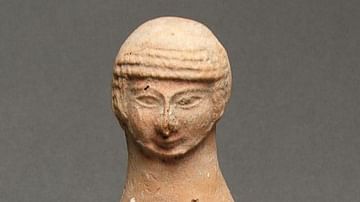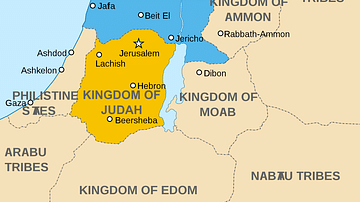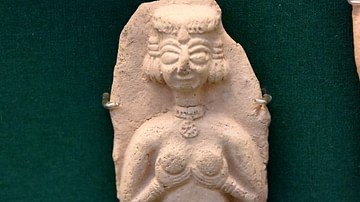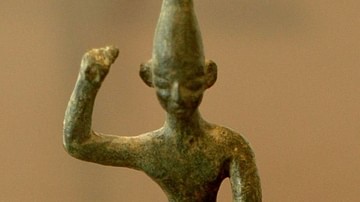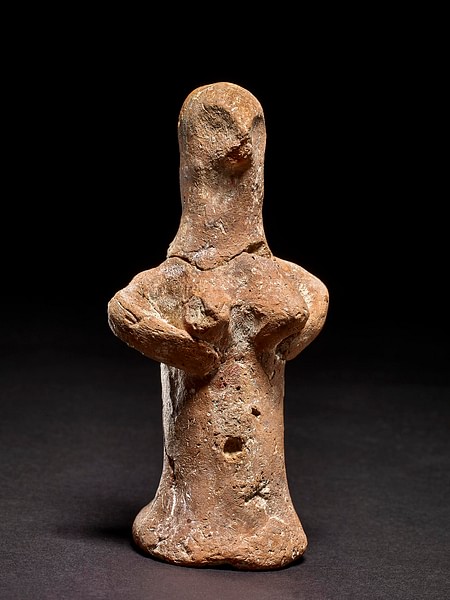
Judean Pillar Figurines are an interesting and specific form of female representation from the Iron Age kingdom of Judah. They fall into a broader category of pillar figurines, which have a pole-like lower body and have been found throughout the Near East and the Mediterranean from the 2nd millennium BCE into classical times. Hundreds of small Judean pillar figurines (JPFs) have been found in Iron Age Judah, some whole, but the majority in fragments, and it is often postulated that they are cult objects, although their purpose is not definitively known.
Material & Form
Iron Age Judean pillar figurines were made of clay with cylindrical bases, which are wider at the bottom, and were either crafted by hand or with a wheel. Their heads were either molded or pinched on top. The heads were sometimes painted and often show the hair in curls, and occasionally, they have a cap or veil. The upper parts of the bases feature pronounced breasts with the arms often curved so that the hands are supporting the breasts. Similar to Phoenician-style female figures, JPFs have been found all over Judah with dates ranging primarily from the end of the 8th to the beginning of the 6th century BCE. In the Northern Kingdom of Israel, people made figurines of the full female body, while in Judah, female figurines consisted of only a female head on the pillar-type body described above. Neither type was particularly artistic, but the southern figurines show more individual characteristics, such as with the hairstyles and what appears to be painted-on jewelry.
Purpose
The majority of the JPFs found were broken, but whole JPFs have been found in cisterns, pits, domestic rooms, a casemate room, a storehouse. Although some were also found in tombs, there are not enough in that context to associate them with death and burial cults. In households, they appear in conjunction with cultic assemblages. At Tell en-Nasbeth and other places, these figures appear to have a variety of possible uses such as votives, cultic images, and devotional objects. These figurines occur so frequently that one scholar, Milton C. Moreland in his book Between Text and Artifact: Integrating Archaeology in Biblical Studies Teaching, states: "In fact, it can be calculated that there were one or more pillar figurines per household" (46). Moreland also suggests they could have been used in household rituals as they were found in assemblages consisting of objects such as Bes images, amulets, beads, lamps, and pendants. This is in line with the theory that they were used in private cultic activities instead of in the larger community cult.
The appearance of these pillar figurines in Iron Age Judah accompanies other changes in Judean clay figurines as well. Although male figures continued to be created, they were not nearly as predominate as the female figures, and their popularity began to decline. Although the female figures have conspicuous breasts (often considered to be linked with fertility), male figures, such as those found at Tell en-Nasbeh, do not emphasize the phallus as one would expect if small figurines were associated with fertility. Another change in Judean figurines was that plaques with female figures – often holding divine symbols, possibly relating to Astarte, Qudshu, or Anath – also declined in the south.
After the Judeans returned from the Babylonian Exile, these pillar figurines disappear from Jewish sites in the archaeological record. However, pillar figurines continued to be used in areas occupied by the Idumeans and Phoenicians during that period.

There are many theories about the uses of these figures including that they represented a goddess (perhaps Asherah or Astarte) or that they were used in sympathetic magic rituals by women to promote fertility. Some scholars have also developed other theories about JPFs, such as that they were toys or figures of mortal human beings; however, neither one of these theories is very popular. Figurines in the ancient Near East were sometimes used as amulets to counteract sexual impotence and perhaps JPFs were used similarly. Another suggestion has been that they were perhaps erotic in nature and used as a type of aphrodisiac for the place of residence. Alternatively, they may have been used as offerings to deities.
Association with Asherah
One of the more popular theories is that the Judean pillar figurines are related to the goddess Asherah. Since the earliest studies, some scholars, such as Kelso and Thorley, have seen a connection between the pillared bodies of the JPFs and the tree or pole symbology used in association with Asherah. However, one should note though that this pillared base was a pragmatic way for figurines to stand up and was common in figurines in the ancient Near East. For example, horse and rider figurines have been found which have pillared bases but cannot logically be linked to a tree in the same way the wooden asherah could be.
It would also seem that for many scholars the figures' pronounced breasts link them to fertility, an attribute of Astarte (who in turn is often linked to Asherah). The goddess Asherah, as the mother of the gods in Canaanite mythology, could also be linked to fertility. As Raz Kletter points out in his book The Judean Pillar-Figurines and the Archaeology of Asherah, nakedness and attributes of fertility representations are fairly generic and could be related to a number of different goddesses. Aside from the two types of heads (pinched and molded), the JPFs do not have common enough distinctions to identify them as specifically different goddesses (or people for that matter).
In the early 20th century CE, JPFs were often believed to be the goddess Astarte rather than Asherah. Although, as previously described, Astarte and Asherah may be related. One scholar that held this view was D. Makenzie, who excavated at Beth Shemesh in the early 1900s CE. He believed they were protective cultic objects. Although originally the JPFs at Beth Shemesh were dated to the 10th century BCE or later, W. F. Albright, an important biblical archaeologist, dated them to be from the 7th-6th centuries BCE. Albright saw them as nurturing goddesses and also believed some of their heads were made in Cyprus while their bodies were made locally.
In 1924 CE, E. Pilz produced an early comprehensive study of figurines from Israel. Pilz also saw the JPFs as nurturing goddesses and perhaps Cypriot or Phoenician Astarte figures. Some scholars, such as K. M. Kenyon, hesitated to attach a particular name to the figures but still believed they were fertility cult objects. J. B. Pritchard, who found many JPFs in private residences at Tell Beit Mirsim, theorized that the pillar figurines evolved from the earlier plaque representations of females and were intended for domestic, fertility cult use. R. Hestin also ascribed to the theory that the JPFs were fertility objects. Some scholars believe they were used as part of sympathetic magic, representing the desire to be a nursing mother.
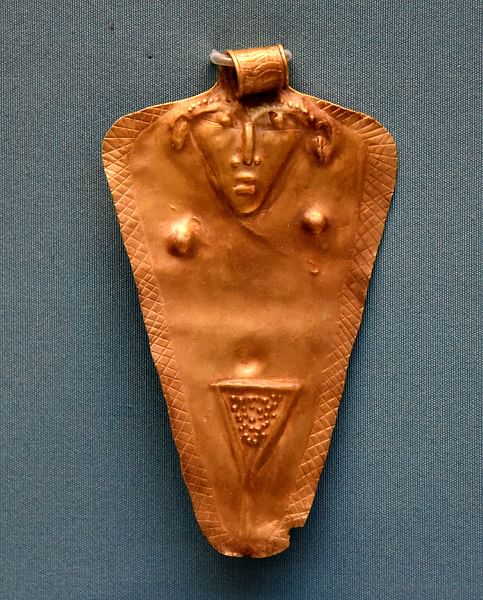
William Dever took the goddess connection a step further and theorized that Asherah was one and the same as the goddesses Anat, Astarte, Elat, and Kudshu. One point of his reasoning is the similarity between the hairstyles of the Asherah representation found at Kuntillet Ajrud and the Syro-Palestinian Astarte figures from the 9th-8th centuries BCE. For him, the Kuntillet Ajrud and Khirbet el-Qom inscriptions were conclusive proof of an Asherah cult in Israel and that the JPFs were physical vestiges of this cult and used as fertility talismans. On the other hand, it must be mentioned that although the Kuntillet Ajrud and Khirbet el-Qom inscriptions associate Yahweh with Asherah, there were no JPFs found in association with the important Yahwistic temple found in Arad.
R. A. S. Macalister who excavated at Gezer believed the JPFs were representations of a goddess or were perhaps the teraphim (household gods) attested to in the Bible. The teraphim in the Jacob and Rachel story in Genesis 30, written down in Iron Age II, are described as being small enough to be hidden in the corners of a tent. It was believed by excavators at Gezer and Tell en-Nasbeth that the figurines were deliberately broken, perhaps in magic rituals. Z. Zevit believes the findings at Tell en-Nasbeh imply ritualistic breaking since all but one of the 120 JPFs found there were broken, most at the neck. Since many were made in one piece and therefore did not have a weak spot at the neck, this breakpoint may be significant. In 1985 CE, G. Barkay theorized that JPFs were broken during King Josiah's monotheistic religious reforms described in the Deuteronomic history in the Bible.
Conclusion
Although JPFs are often thought to be associated with fertility, the large number and widespread use seem out of proportion with the number of infertility issues people of that time and region most likely experienced, as Zevit points out in The Religions of Ancient Israel: A Synthesis of Parallactic Approaches. That the figures are holding their breasts might suggest a giving pose, rather than a sympathetic posture for receiving fertility. Instead of being attempts at coercing a deity or a magical force to provide women with greater fertility, perhaps they represented the need to be nurtured from the supernatural world. The idea of being nurtured, either in an emotional or general well-being sense, is more abstract than the desire to be fertile or to lactate, but health and wellness would have been just as important in ancient times as they are in today's world. Perhaps not so coincidentally, Athirat (Asherah) was described in Canaanite texts as breastfeeding a king. In Tell Qasile, stratum XI from the 11th century BCE, Iron Age IB, a clay vessel was found in the shape of a naked female upper body, similar to the JPFs. However, unlike the JPFs, it has an opening at the top of its head and holes in its breasts thought to be for pouring liquids. It may be that the user was meant to suck from the breasts, instead of pour.

